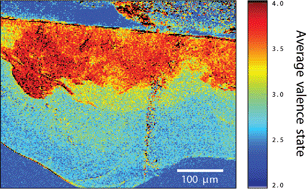Micro-XANES study on Mn browning: use of quantitative valence state maps
Abstract
Historical glass, especially non-durable medieval glass, can undergo corrosion. This sometimes results in the formation of dark-coloured manganese-rich inclusions that reduce the transparency of the glass. While unaltered bulk glass contains manganese mainly present in the +II valence state, inside the inclusions Mn is present in higher valence states (+III to +IV). Two different strategies may be considered by conservators when aiming to improve the transparency. One is based on the reduction of highly oxidised black/brown compounds using mildly reducing solutions, while the other focuses more on the extraction of manganese from the inclusions by the application of chelating agents. In this paper, a method for quantitative mapping of the Mn speciation inside partially corroded historical windowpanes based on X-Ray Absorption Near-Edge Structure (XANES) spectroscopy is discussed. The calibration of such Mn valence state maps based on the combo method, a fairly reliable way to determine the oxidation state, is described in more detail. This method is used to evaluate the effect of reducing treatments on historical glass, dated to the 14th century and originating from Sidney Sussex College (Cambridge, UK), suffering from Mn browning. Glasses were examined by means of Synchrotron Radiation (SR) based microscopic X-Ray Absorption Near-Edge Structure (μXANES) spectroscopy and microscopic X-Ray Fluorescence (μXRF). X-Ray elemental distribution maps of glass cross-sections are recorded at different energies, while Mn K-edge spectra are used to convert these into Mn valence state (VS) maps. Such valence state maps will allow evaluation of a reducing treatment.

- This article is part of the themed collection: Synchrotron radiation and neutrons in art and archaeology

 Please wait while we load your content...
Please wait while we load your content...